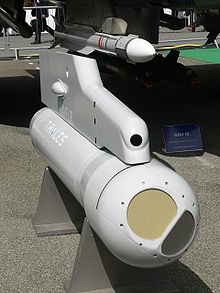A laser designator is a laser light source which is used to designate a target. Laser designators provide targeting for laser-guided bombs, missiles, or precision artillery munitions, such as the Paveway series of bombs, AGM-114 Hellfire, or the M712 Copperhead round, respectively.
When a target is marked by a designator, the beam is invisible and does not shine continuously. Instead, a series of coded laser pulses, also called PRF codes (pulse repetition frequency), are fired at the target. These signals bounce off the target into the sky, where they are detected by the seeker on the laser-guided munition, which steers itself towards the centre of the reflected signal.[1] Unless the people being targeted possess laser detection equipment or can hear aircraft overhead, it is extremely difficult for them to determine whether they are being marked. Laser designators work best in clear atmospheric conditions. Cloud cover, rain or smoke can make reliable designation of targets difficult or impossible unless a simulation is accessible through available ground data.
Deployment
editLaser designators may be mounted on aircraft, ground vehicles, naval vessels, or handheld. Depending on the wavelength of light used by the designator, the designation laser may or may not be visible to the personnel deploying it. This is the case with 1064 nm laser designators used by JTACs as that wavelength of light is difficult to see under standard Gen III/III+ night vision devices.[2] Other imaging devices with "see-spot" capabilities to "see" the laser spot are often utilized to make sure the target is being correctly designated. These may include FLIR (forward looking infrared) thermal imagers which normally operate in the MWIR or LWIR spectrum[3] but have a 1064 nm window in which they can see-spot the laser.[4]
Airborne
editThe U.S. Air Force selected the Lockheed Martin's Sniper Advanced Targeting Pod (ATP) in 2004. It equipped multiple USAF platforms such as the F-16, F-15E, B-1, B-52, and A-10C. It also operates on multiple international fighter platforms. The U.S. Navy currently employ LITENING and ATFLIR targeting pods on a variety of strike aircraft.[5] The Litening II is widely used by many other of the world's air forces. The United Kingdom's Royal Air Force use the Litening III system and the French use the TALIOS (Targeting Long-range Identification Optronic System),[6][circular reference] Damocles and ATLIS II.
Ground-based
editMany modern armed forces employ handheld laser designation systems. Examples include the AN/PEQ-1 SOFLAM of the United States, the Russian LPR series of handheld devices.
U.S. Air Force Joint Terminal Air Controllers and Marine Corps Forward Air Controllers typically employ a lightweight device, such as the AN/PED-1 Lightweight Laser Designator Rangefinder (LLDR), permitting them to designate targets for Close Air Support aircraft flying overhead and in close proximity to friendly forces. While many designators are binocular-based and may utilize tripods, smaller handheld laser designators, like the B.E. Meyers & Co. IZLID 1000P exist as well.[7] Northrop Grumman's LLDR, using an eye-safe laser wavelength, recognizes targets, finds the range to a target, and fixes target locations for laser-guided, GPS-guided, and conventional munitions.[8] This lightweight, interoperable system uniquely provides range finding and targeting information to other digital battlefield systems[9] allowing the system to provide targeting information for non-guided munitions, or when laser designation is unreliable due to battlefield conditions.
Gallery
edit-
The Soviet-era LPR-1 laser designator.
-
The LPR-2 laser designator.
-
The LPR-4 laser designator.
-
The Lightweight Laser Designator Rangefinder.
-
JGSDF Middle range Multi-Purpose missile laser designator.
See also
editReferences
edit- ^ U.S. Marine Corps (4 April 2018). "MCTP 3-10F Fire Support Coordination in the Ground Combat Element" (PDF). Marines.mil. pp. Appendix K. Archived from the original (PDF) on 16 July 2022. Retrieved 16 July 2022.
- ^ "Differences between Gen3 and 4G image intensification technology" (PDF). Photonis Night Vision. October 2020. Archived from the original (PDF) on 5 May 2021. Retrieved 16 July 2022.
- ^ "Thermal Camera Specs You Should Know Before Buying". FLIR.com. 18 December 2019. Archived from the original on 7 April 2022. Retrieved 16 July 2022.
- ^ Donval, Ariela; Fisher, Tali; Lipman, Ofir; Oron, Moshe (1 May 2012). "Laser designator protection filter for see-spot thermal imaging systems". In Andresen, Bjørn F.; Fulop, Gabor F.; Norton, Paul R. (eds.). Infrared Technology and Applications XXXVIII. Proceedings of SPIE. Vol. 8353. Bibcode:2012SPIE.8353E..24D. doi:10.1117/12.916966. S2CID 122190698.
- ^ "Fact Sheet - LITENING II". 24 June 2003. Archived from the original on 24 June 2003.
{{cite web}}: CS1 maint: bot: original URL status unknown (link) - ^ fr:Pod Talios
- ^ "IZLID 1000P". B.E. Meyers & Co. Archived from the original on 19 May 2022. Retrieved 29 June 2022.
- ^ "Lightweight Laser Designator Rangefinder (LLDR)" (PDF). Northrop Grumman. Archived from the original (PDF) on 5 August 2019. Retrieved 4 June 2022.
- ^ "Photo Release -- U.S. Army Awards Northrop Grumman Lightweight Laser Designator Rangefinders Delivery Order Valued at $142.7 Million (NYSE:NOC)". Archived from the original on 2010-03-25.
Further reading
edit- Lightweight Laser Designator Rangefinder Archived 2019-11-02 at the Wayback Machine, Northrop Grumman


